Description
The theatre occupies three blocks annexed to the ancient city walls, along the Roman main road (the decumanus maximus , next to the Porta Prætoria. The structure occupied an area of 81 by 64 metres (266 by 210 ft), and could contain up to 3,500/4,000 spectators.
What remains today include the southern façade, standing at 22 metres (72 ft). The cavea was enclosed in a rectangular-shaped wall including the remaining southern part. This was reinforced by buttresses each 5.5 metres (18 ft) from the other, and included by four orders of arcades which lightened its structure. It has been supposed that the theatre once had an upper cover, in the same way of the Theatre of Pompey in Rome.
The orchestra had a diameter of 10 metres (33 ft). The scene, of which only the foundations remain, was decorated by Corinthian columns and statues and was covered with marble slabs.
A marketplace surrounded by storehouses on three sides with a temple in the centre with two on the open (south) side, as well as a thermae, also have been discovered.

Pergamon or Pergamum, also referred to by its modern Greek form Pergamos, was a rich and powerful ancient Greek city in Mysia. It is located 26 kilometres (16 mi) from the modern coastline of the Aegean Sea on a promontory on the north side of the river Caicus and northwest of the modern city of Bergama, Turkey.

Quiriguá is an ancient Maya archaeological site in the department of Izabal in south-eastern Guatemala. It is a medium-sized site covering approximately 3 square kilometres (1.2 sq mi) along the lower Motagua River, with the ceremonial center about 1 km (0.6 mi) from the north bank. During the Maya Classic Period (AD 200–900), Quiriguá was situated at the juncture of several important trade routes. The site was occupied by 200, construction on the acropolis had begun by about 550, and an explosion of grander construction started in the 8th century. All construction had halted by about 850, except for a brief period of reoccupation in the Early Postclassic. Quiriguá shares its architectural and sculptural styles with the nearby Classic Period city of Copán, with whose history it is closely entwined.

Aosta is the principal city of Aosta Valley, a bilingual region in the Italian Alps, 110 km (68 mi) north-northwest of Turin. It is situated near the Italian entrance of the Mont Blanc Tunnel, at the confluence of the Buthier and the Dora Baltea, and at the junction of the Great and Little St Bernard Pass routes.
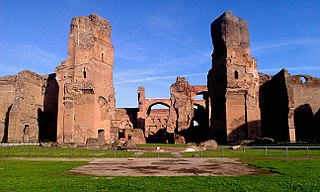
The Baths of Caracalla in Rome, Italy, were the city's second largest Roman public baths, or thermae. The baths were likely built between AD 212 and 216/217, during the reigns of emperors Septimius Severus and Caracalla. They were in operation until the 530s and then fell into disuse and ruin.
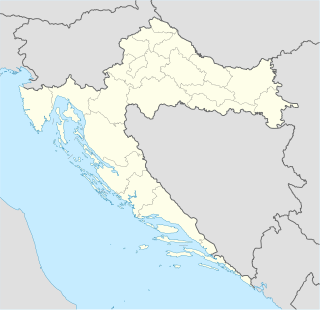
Salona was an ancient city and the capital of the Roman province of Dalmatia. Salona is located in the modern town of Solin, next to Split, in Croatia.
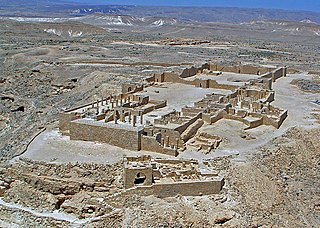
Avdat, also known as Abdah and Ovdat and Obodat, is a site of a ruined Nabataean city in the Negev desert in southern Israel. It was the most important city on the Incense Route after Petra, between the 1st century BCE and the 7th century CE. It was founded in the 3rd century BCE, and inhabited by Nabataeans, Romans, and Byzantines. Avdat was a seasonal camping ground for Nabataean caravans travelling along the early Petra–Gaza road in the 3rd – late 2nd century BCE. The city's original name was changed to Avdat in honor of Nabataean King Obodas I, who, according to tradition, was revered as a deity and was buried there.
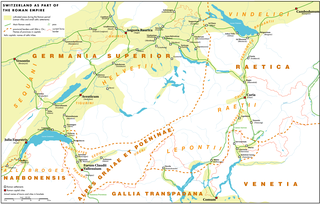
Aventicum was the largest town and capital of Roman Switzerland. Its remains are beside the modern town of Avenches.
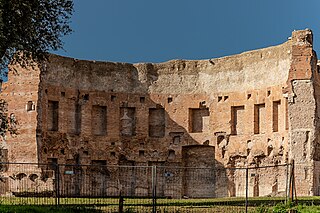
The Baths of Trajan were a massive thermae, a bathing and leisure complex, built in ancient Rome starting from 104 AD and dedicated during the Kalends of July in 109. Commissioned by Emperor Trajan, the complex of baths occupied space on the southern side of the Oppian Hill on the outskirts of what was then the main developed area of the city, although still inside the boundary of the Servian Wall. The architect of the complex is said to be Apollodorus of Damascus. The baths were being utilized mainly as a recreational and social center by Roman citizens, both men and women, as late as the early 5th century. The complex seems to have been deserted soon afterwards as a cemetery dated to the 5th century has been found in front of the northeastern exedra. The baths were thus no longer in use at the time of the siege of Rome by the Ostrogoths in 537; with the destruction of the Roman aqueducts, all thermae were abandoned, as was the whole of the now-waterless Mons Oppius. Early Christian writers misnamed the remains the 'Baths of Domitian'.
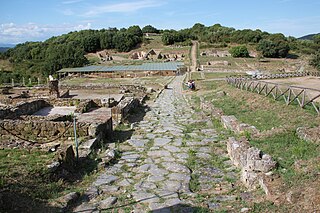
Rusellae was an important ancient town of Etruria, which survived until the Middle Ages before being abandoned. The impressive archaeological remains lie near the modern frazione or village of Roselle in the comune of Grosseto.

Hierapolis was an ancient Greek city located on hot springs in classical Phrygia in southwestern Anatolia. Its ruins are adjacent to modern Pamukkale in Turkey and currently comprise an archaeological museum. The site has the Tomb of Philip the Apostle.
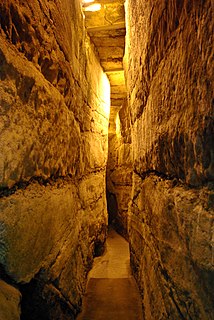
The Western Wall Tunnel is a tunnel exposing the Western Wall from where the traditional, open-air prayer site ends and up to the Wall's northern end. Most of the tunnel is in continuation of the open-air Western Wall and is located under buildings of the Muslim Quarter of the Old City of Jerusalem. While the open-air portion of the Western Wall is approximately 60 metres (200 ft) long, the majority of its original length of 488 metres (1,601 ft) is hidden underground. The tunnel allows access to the remainder of the Wall in a northerly direction.

The Pons Cestius is an ancient Roman bridge connecting the right bank of the Tiber with the west of the Tiber Island in Rome, Italy. In Late Antiquity, the bridge was replaced and renamed the Pons Gratiani. It is also known as the Italian: Ponte San Bartolomeo, lit. 'Bridge of Saint Bartholomew'. No more than one third of the present stone bridge is of ancient material, as it was entirely rebuilt and extended in the 19th century, after numerous earlier restorations.

Incense Route – Desert Cities in the Negev is a World Heritage-designated area near the end of the Incense Route in the Negev, southern Israel, which connected Arabia to the Mediterranean in the Hellenistic-Roman period, proclaimed as being of outstanding universal value by UNESCO in 2005. The trade led to the development of ancient towns, forts and caravanserai en route, apart from agricultural development.

Halabiye is an archaeological site on the right bank of the Euphrates River in Deir ez-Zor Governorate, Syria. It was an ancient city and former bishopric known as Zenobia and a Latin Catholic titular see.

see also the city "Cius" or "Kios"

El Chal is a pre-Columbian Maya archaeological site located in the upper San Juan River valley of the southeastern Petén Basin region, Guatemala. The site is situated in the municipality of El Chal, lying some 600 metres (2,000 ft) to the south of the municipal seat also called El Chal.

The Pergamon Bridge is a Roman substruction bridge over the Selinus river in the ancient city of Pergamon, modern-day Turkey. The 196 m (643 ft) wide structure, the largest of its kind in antiquity, was designed during Hadrian's reign (AD 117–138) in order to form a passageway underneath a large court in front of the monumental "Red Basilica" temple complex. The two intact tubes, which consist of supporting walls covered with barrel vaults, still serve their purpose to this day.

The "Red Basilica", also called variously the Red Hall and Red Courtyard, is a monumental ruined temple in the ancient city of Pergamon, now Bergama, in western Turkey. The temple was built during the Roman Empire, probably in the time of Hadrian and possibly on his orders. It is one of the largest Roman structures still surviving in the ancient Greek world. The temple is thought to have been used for the worship of Egyptian gods – specifically Isis and/or Serapis, and possibly also Osiris, Harpocrates and other lesser gods, who may have been worshipped in a pair of drum-shaped rotundas, both of which are virtually intact, alongside the main temple.

The fortifications of Bangkok consist of several series of defensive structures built to protect the city during the late Ayutthaya to early Rattanakosin periods. The earliest structures were built when Bangkok was an outpost of Ayutthaya guarding entry to the Chao Phraya River during the 15th–16th centuries. These were reinforced when the city became the site of the short-lived capital of Thonburi after the fall of Ayutthaya in 1767. New walls and forts were built when the city of Rattanakosin replaced Thonburi in 1782, which were mostly removed and replaced in the second half of the 19th century in order to accommodate the expanding city. Today, four of the city's defensive forts remain, along with two short sections of the Rattanakosin city wall and one of the city gates.

Uzuncaburç is an archaeological site in Mersin Province, Turkey, containing the remnants of the ancient city of Diokaisareia or Diocaesarea.



















